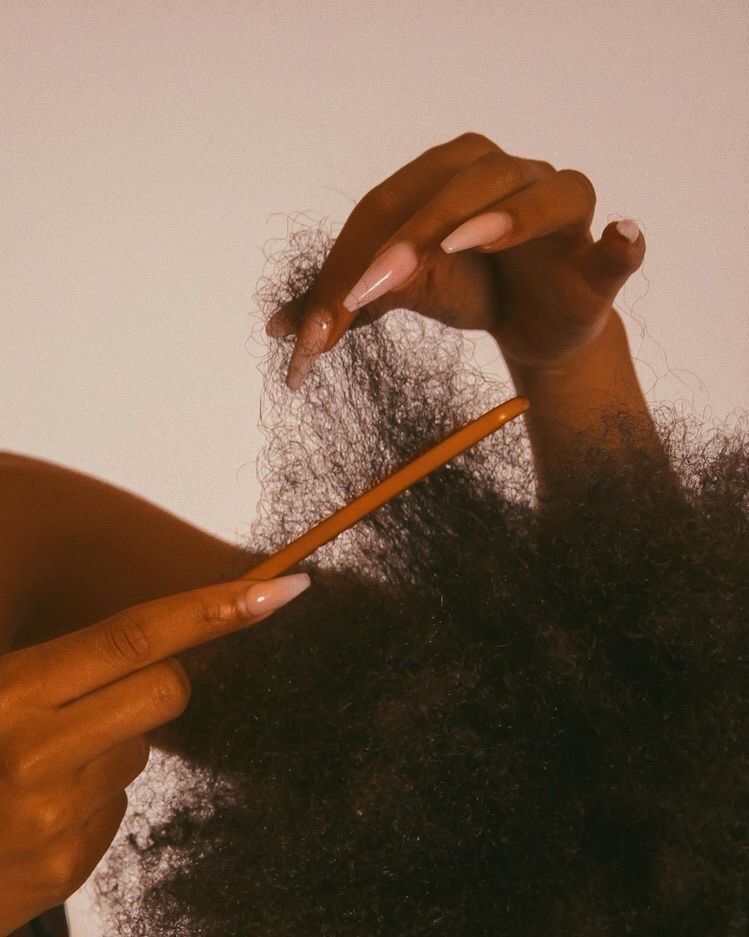Hair Porosity: How it influences your Hair Regimen

If you're in the thick of understanding your child's hair and what products best suit it, you've likely come across the word "porosity." Porosity is a word that has been used around the natural hair care community for a while now. Porosity is a significant factor in your hair care regimen and how your hair responds to various products. Many hair terms exist throughout the natural hair community; however, Porosity is a word worth understanding as it directly impacts the effectiveness of your hair regimen.
What is Hair Porosity?
Porosity, simplified, is your hair's ability to retain and absorb moisture and product. Emphasis has always been on hair type and texture but beyond that, understanding your hair porosity is argumental the most important. Porosity allows us to understand how and why our hair interacts with specific products and weigh the effectiveness of our hair regimens.

The Three Categories of Porosity
There are three categories of Porosity: low, medium, and high. Each of these categories has its distinct characteristics. Determining your Porosity depends on identifying how your hair cuticles respond to the application of heat or water.
- Low Porosity: Cuticles sit close together
- Medium Porosity: Cuticles are less compact
- High Porosity: Cuticles are widely spaced
Understanding Hair Porosity
Variation exists throughout any head of hair. It's important to note that, like hair textures, you can have different hair porosities throughout your hair. Your hair may even consist of all three porosities. Remember that your hair can have characteristics of each Porosity as you read. Use the list and any recommendations shared as a starting point and develop your regimen and assess your hair needs from there.
Are Hair Type and Porosities Related?
There is a lot of information comparing hair type and hair porosities. However, factors like hair type and texture don't equate to specific hair porosity. You will find that two people with the same hair type may have different hair porosities. Environmental factors, stressors, climate, and genetics can explain this reasoning. Hair is unique; there is not a one-size-fits-all approach.
Low Porosity
In low porosity hair, you will find that cuticles of the hair are packed tightly together and may overlap. Because of this, it is harder for water and hair products like oils and conditioners to penetrate the hair and provide moisture to the hair shaft.
Characteristics of Low Porosity Hair
Unlike the other medium and high Porosity, Low Porosity hair is typically due to genetics and not the result of using chemicals and heat. With Low Porosity hair, you'll likely experience the following;
- Products sit on your hair: Due to the formation of hair cuticles, low porosity hair has a more challenging time absorbing hair products. Products tend to sit on top of the hair rather than being absorbed. Recommendations are that if you have low porosity hair, you steer clear of sealing oils as they'll be counteractive to your efforts to get moisture in your hair cuticles. Steam treatments are great to introduce to your hair regimen, as the steam helps lift cuticles allowing product and water to seep in.
- It takes longer to wash and dry: Getting moisture into Low Porosity hair is challenging. For this reason, it takes longer for water to penetrate the Low Porosity hair shaft while washing. After successfully getting water into the hair, it's also difficult to dry it through indirect methods, such as airdrying and a blow dryer.
Here, you can find specific product recommendations and additional characteristics for Low Porosity hair.
High Porosity
In high porosity hair, hair's cuticles are widely spaced. This hair cuticle formation makes it easy for hair products and moisture to enter the hair shaft and easy for moisture to leave the hair.
Characteristics of High Porosity Hair
You can have high porosity hair due to heat, chemical damage, or genetics. With High Porosity hair, you'll likely experience the following;
- Absorbs product Quickly: Although it is easier to introduce moisture to the hair shaft with High Porosity, it's harder to retain. As a result, High Porosity hair can look dry and dull while also being more prone to breakage. Recommendations for High Porosity include Heavy creams and sealing oils to help seal moisture.
- Hair Dries Quickly: Although High Porosity hair absorbs moisture quickly, it also quickly escapes taking less time for the hair shaft to completely dry. A quick-drying time can work in your favor in many ways but also against you as it reduces the amount of time for hair products to work effectively. Incorporating deep-conditioning treatments partnered with indirect heat is an effective way to seal moisture for High Porosity hair.
You can find specific product recommendations and additional characteristics for High Porosity hair here.
Medium Porosity
Medium Porosity sometimes referred to as "normal" Porosity, is between low and high porous hair. Medium porosity hair cuticles are uniform and spaced apart in which they aren't overlapping but also close enough to where no significant gap between cuticles.
Characteristics of Medium Porosity Hair
The overuse of heat or chemicals can manipulate the Medium Porosity hair causing it to change over time. With Medium Porosity hair, you'll likely experience the following;
- Absorbs and retains moisture well: The uniform cuticle allows hair to absorb the right amount of product and water.
- It doesn't take long for hair to air dry or dry: Hair cuticles are neither spaced tightly nor loosely apart, allowing for a "balanced" indirect drying time.
Here, you can find specific product recommendations and additional characteristics for Medium Porosity hair.
Testing Hair Porosity
Testing your hair porosity can be done at home. Listed below are the four most common hair porosity tests. Perform one(or all) of these tests with clean hair for the most accurate reading, and you do not want the product to interfere with your hair's natural response to water/moisture. The four hair porosity test are listed below;
- Float Test:
- Slip and Slide
- Dry Test
- Watershed Test
The Float Test
The most common porosity test is the Float Test. This test involves adding 2-3 strands of clean hair to a glass cup.
Tools needed:
- Clear glass cup filled with water
- 2-3 clean strands of hair
Performing the "Float Test"
- Fill a clear, clean glass with water.
- Collect a few strands of your hair.
- Place your strand of hair in a glass of water. Watch how it responds.
- Review the position of your hair strands;
- Low Porosity- if hair floats.
- Medium Porosity- hair floats in the middle.
- High Porosity- hair sinks to the bottom.
Repeat this process with strands from different parts of your head. Note the results.
This test alone may not truly identify your hair porosity level. Try another method to compare results and make your final judgment.
Slip and Slide Test
The Slip and Slide Test is one of the less recommended tests but the most desirable if you don't want to apply water to your hair or pull out strands.
Tools Needed:
- Hand
- Hair
Performing the Slip and Slide Test
- Separate a strand of hair between your fingertips.
- Gently work your fingertips towards your scalp.
- Low Porosity- Smooth at the root.
- High Porosity- Textured at the root.
Medium Porosity isn't accounted for here, furthering the reason for it being one of the least recommended tests; however, it's an excellent alternative for those not interested in one of the other methods.
Dry Test
The Dry Test is a test performed during your wash day.
Tools Needed:
- Shampoo
- Patience
- Hair
Performing the Dry Test
- Wash hair with shampoo and rinse
- Do not apply conditioner or any additional product afterward.
- Allow hair to air dry
- Allow your body to air dry
- Low Porosity- if your body hair dries before your hair
- High Porosity- if your hair dries before your body hair
The dry test is said to be a viral test, but we have to question different factors that would dispute the test's validity. For one, the hair on your head is denser than your body hair; therefore, one would assume body hair will naturally dry faster regardless of hair porosity.
Watershed Test
The Watershed Test is the most equivalent to washing your hair. Dependent on your hairstyle, you may not desire to perform this test.
Tools Needed:
- Spray Bottle
- Hair
Performing the Watershed Test
- Fill the spray bottle with clean water
- Spray a section of clean hair
- Low Porosity- beads will formulate on the top of the hair
- Medium Porosity- will absorb hair at a balanced rate
- High Porosity- will absorb the water quickly.
When performing any of the tests above, I recommend taking it a step further. Using your strand or section of hair used to perform any of the mentioned tests, apply your favorite shampoo, rinse and then follow with a conditioner. Determine how your tested hair sample responds. Don't stop there; follow up with your favorite serum, etc. You genuinely want to take advantage of the moment and study how your hair responds to different products you use throughout your hair regimen.
Porosity Matters
In short, hair porosity matters! Not only does it help to identify what products to use and work best with your hair, but it also plays an essential role in helping with your styling selections. As it essentially allows you to learn how to style your hair. If you don't have time to perform a porosity test, many online quizzes ask questions to help you identify your hair porosity. You can also study and watch how your hair reacts to specific products and ingredients. An important takeaway is that all hair is unique. What works for some does not always work for others. Others swear by-products while others curse them. It's a learning process, and ultimately it may take a few product trials and techniques to effectively learn how to introduce and retain moisture in your hair.




Comments